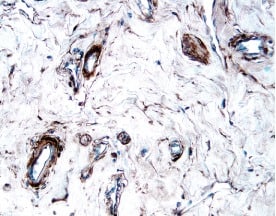Mouse EOMES Antibody Summary
Met1-Ser126
Accession # O54839
Customers also Viewed
Applications
Please Note: Optimal dilutions should be determined by each laboratory for each application. General Protocols are available in the Technical Information section on our website.
Scientific Data
 View Larger
View Larger
Detection of EOMES in Mouse Splenocytes by Flow Cytometry. Mouse splenocytes were stained with Rat Anti-Mouse NKp46/NCR1 APC-conjugated Monoclonal Antibody (Catalog # FAB22252A) and either (A) Rabbit Anti-Mouse EOMES Monoclonal Antibody (Catalog # MAB8889) or (B) Normal Rabbit IgG Control (Catalog # AB-105-C) followed by Phycoerythrin-conjugated Anti-Rabbit IgG Secondary Antibody (Catalog # F0110).
Preparation and Storage
- 12 months from date of receipt, -20 to -70 °C as supplied.
- 1 month, 2 to 8 °C under sterile conditions after reconstitution.
- 6 months, -20 to -70 °C under sterile conditions after reconstitution.
Background: EOMES
EOMES (Eomesodermin), also TBR2, is a 72 kDa member of the TBR1 subfamily, T-box family of transcription factors. It is expressed in NK and CD8+ T cells, where CTLA4 activation suppresses EOMES activation of IFN-gamma and granzyme B genes. It is also found in the embryo, where it occurs in forebrain floorplate and migrating neuroblasts at 12.5 weeks gestation. Notably, it is reported to undergo intercellular transfer in fetal Xenopus tissue destined to become mesoderm. Here, it synchronizes a multicellular commitment to a cell lineage. Human EOMES is 686 amino acids (aa) in length. It contains short poly-Ala, -Gly and -Asn motifs, and a DNA-binding T box (aa 276-456). There is one isoform that shows a 19 aa insertion after Ser460. Over aa 471‑686, human EOMES shares 91% aa identity with mouse EOMES.
Product Datasheets
Citations for Mouse EOMES Antibody
R&D Systems personnel manually curate a database that contains references using R&D Systems products. The data collected includes not only links to publications in PubMed, but also provides information about sample types, species, and experimental conditions.
5
Citations: Showing 1 - 5
Filter your results:
Filter by:
-
Amplification of autoimmune organ damage by NKp46-activated ILC1
Authors: Biniaris-Georgallis, SI;Aschman, T;Stergioula, K;Schreiber, F;Jafari, V;Taranko, A;Karmalkar, T;Kasapi, A;Lenac Rovis, T;Jelencic, V;Bejarano, DA;Fabry, L;Papacharalampous, M;Mattiola, I;Molgora, M;Hou, J;Hublitz, KW;Heinrich, F;Guerra, GM;Durek, P;Patone, G;Lindberg, EL;Maatz, H;Hölsken, O;Krönke, G;Mortha, A;Voll, RE;Clarke, AJ;Hauser, AE;Colonna, M;Thurley, K;Schlitzer, A;Schneider, C;Stamatiades, EG;Mashreghi, MF;Jonjic, S;Hübner, N;Diefenbach, A;Kanda, M;Triantafyllopoulou, A;
Nature
Species: Mouse, Transgenic Mouse
Sample Types: Whole Tissue
Applications: Immunohistochemistry -
Spermatogonial fate in mice with increased activin A bioactivity and testicular somatic cell tumours
Authors: Penny A. F. Whiley, Benedict Nathaniel, Peter G. Stanton, Robin M. Hobbs, Kate L. Loveland
Frontiers in Cell and Developmental Biology
-
Adipose group 1 innate lymphoid cells promote adipose tissue fibrosis and diabetes in obesity
Authors: H Wang, L Shen, X Sun, F Liu, W Feng, C Jiang, X Chu, X Ye, C Jiang, Y Wang, P Zhang, M Zang, D Zhu, Y Bi
Nat Commun, 2019-07-22;10(1):3254.
Species: Human
Sample Types: Whole Cells
Applications: Flow Cytometry -
Blocking the FSTL1-DIP2A Axis Improves Anti-tumor Immunity
Authors: C Kudo-Saito, A Ishida, Y Shouya, K Teramoto, T Igarashi, R Kon, K Saito, C Awada, Y Ogiwara, M Toyoura
Cell Rep, 2018-08-14;24(7):1790-1801.
Species: Mouse
Sample Types: Whole Cells
Applications: Flow Cytometry -
Identification of dynamic undifferentiated cell states within the male germline
Authors: HM La, JA Mäkelä, AL Chan, FJ Rossello, CM Nefzger, JMD Legrand, M De Seram, JM Polo, RM Hobbs
Nat Commun, 2018-07-19;9(1):2819.
Species: Mouse
Sample Types: Whole Tissue
Applications: IHC
FAQs
No product specific FAQs exist for this product, however you may
View all Antibody FAQsIsotype Controls
Reconstitution Buffers
Secondary Antibodies
Reviews for Mouse EOMES Antibody
Average Rating: 5 (Based on 1 Review)
Have you used Mouse EOMES Antibody?
Submit a review and receive an Amazon gift card.
$25/€18/£15/$25CAN/¥75 Yuan/¥2500 Yen for a review with an image
$10/€7/£6/$10 CAD/¥70 Yuan/¥1110 Yen for a review without an image
Filter by:
Cryosections from PLP immersion fixed tissues were stained for EOMES (1:500) for 4h @ RT. After washing, tissue was stained with Goat anti-Rabbit alexa555 2ndary antibody (1:500) for 1h at RT. CD45 in green, EOMES in red, nuclear staining (Hoechst) in blue.




















